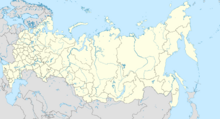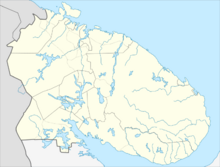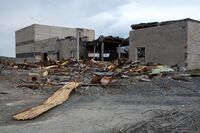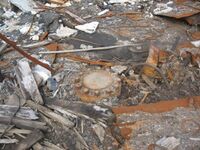Earth:Kola Superdeep Borehole
 Superstructure of the Kola Superdeep Borehole, 2007 | |
| Location | |
|---|---|
| Location | Pechengsky District |
| Province | Murmansk Oblast |
| Country | Russia |
| Coordinates | [ ⚑ ] : 69°23′47″N 30°36′36″E / 69.3965°N 30.6100°E |
| Production | |
| Type | Scientific borehole |
| Greatest depth | 12,262 metres (40,230 ft) |
| History | |
| Opened | 1965 |
| Active |
|
| Closed | 1995 |
The Kola Superdeep Borehole (Russian: Кольская сверхглубокая скважина, romanized: Kol'skaya sverkhglubokaya skvazhina) SG-3[lower-alpha 1] is the result of a scientific drilling project of the Soviet Union in the Pechengsky District, near the Russian border with Norway, on the Kola Peninsula. The project attempted to drill as deep as possible into the Earth's crust.
Drilling began on 24 May 1970 using the Uralmash-4E, and later the Uralmash-15000 series drilling rig, and it became the deepest manmade hole in history in 1979. The 23-centimetre-diameter (9 in) boreholes were drilled by branching from a central hole.[1] The deepest reached 12,262 metres (40,230 ft; 7.619 mi) in 1989, the deepest human-made hole on Earth, and remains so (As of 2024).
In terms of true vertical depth, it remains the deepest borehole in the world. For two decades, it was also the world's longest borehole in terms of measured depth along the well bore (that is, borehole length) until it was surpassed in 2008 by the 12,289-metre-long (40,318 ft; 7.636 mi) Al Shaheen Oil Well in Qatar.[2]
Drilling
Drilling began on 24 May 1970 using the Uralmash-4E, a serial drilling rig used for drilling oil wells. The rig was slightly modified to be able to reach a 7,000-metre (23,000 ft) depth. In 1974, the new purpose-built Uralmash-15000 drilling rig was installed onsite, named after the new target depth, set at 15,000 metres (49,000 ft).[3]
On 6 June 1979, the world depth record held by the Bertha Rogers hole in Washita County, Oklahoma, United States, at 9,583 metres (31,440 ft),[4] was broken. In October 1982, the first hole reached 11,662 metres (38,261 ft),[5] and the second hole was started in January 1983 from a 9,300-metre (30,500 ft) depth of the first hole.[3]
In 1983, the drill passed 12,000 metres (39,000 ft) in the second hole, and drilling was stopped for about a year for numerous scientific and celebratory visits to the site.[6]
This idle period may have contributed to a breakdown after drilling resumed; on 27 September 1984, after drilling to 12,066 metres (39,587 ft), a 5 metres (16 ft) section of the drill string twisted off and was left in the hole. Drilling was restarted in September 1986, 7,000 metres (23,000 ft) from the first hole.[6][5]
The third hole reached 12,262 metres (40,230 ft) in 1989.[7] In that year, the hole depth was expected to reach 13,500 metres (44,300 ft) by the end of 1990 and 15,000 metres (49,000 ft) by 1993.[8][9][failed verification]
In June 1990, a breakdown occurred in the third hole at 12,262 metres (40,230 ft) of depth. The drilling of the fourth hole was started in January 1991 from 9,653 metres (31,670 ft) of depth of third hole. The drilling of the fourth hole was stopped in April 1992 at 11,882 metres (38,983 ft) of depth. Drilling of the fifth hole started in April 1994 from 8,278 metres (27,159 ft) of depth of the third hole. Drilling was stopped in August 1994 at 8,578 metres (28,143 ft) of depth due to lack of funds and the well itself was mothballed.[5][10]
During the drilling process, unexpectedly no basaltic layers were found at seven kilometers down or at any depth in the borehole.[11] Prior to that, geological information about the Earth's crust was mostly based on analyzing seismic waves that indicated discontinuity.[11] Scientific models had previously suggested basalt should be seen. Instead, the actual geological evidence from the borehole revealed there were more granites, and at much greater depths than scientists had considered.[11] It was then thought by scientists that seismic discontinuity was caused by granite metamorphosis instead of basalts.[11] In addition to this, water was unexpectedly found at three to six kilometers deep.[11] Water was not naturally vaporizing at any depth in the borehole.[12] Instead, water was found at these greater depths.[13] Scientific models previously had not predicted water to be found at such great depths.[14] It was discovered that deep granites can be fractured and receive water this deep.[15] As a result of these findings, many scientists now theorize that aquifers of water can be found at much greater depths than older scientific models had previously thought possible.[16][17][11]
Research
The Kola Superdeep Borehole penetrated about a third of the way through the Baltic Shield continental crust, estimated to be around 35 kilometres (22 mi) deep, reaching Archean rocks at the bottom.[18] The project has been a site of extensive geophysical examinations. The stated areas of study were the deep structure of the Baltic Shield, seismic discontinuities and the thermal regime in the Earth's crust, the physical and chemical composition of the deep crust and the transition from upper to lower crust, lithospheric geophysics, and to create and develop technologies for deep geophysical study.
To scientists, one of the more fascinating findings to emerge from this well is that no transition from granite to basalt was found at the depth of about seven kilometres (4.3 mi), where the velocity of seismic waves has a discontinuity. Instead, the change in the seismic wave velocity is caused by a metamorphic transition in the granite rock. In addition, the rock at that depth had been thoroughly fractured and was saturated with water, which was surprising. This water, unlike surface water, must have come from deep-crust minerals and had been unable to reach the surface because of a layer of impermeable rock.[19]
Microscopic plankton fossils were found six kilometres (3.7 mi) below the surface.[1]
Another unexpected discovery was a large quantity of hydrogen gas. The drilling mud that flowed out of the hole was described as "boiling" with hydrogen.[20]
In 1992, an international geophysical experiment obtained a reflection seismic crustal cross-section through the well. The Kola-92 working group consisted of researchers from the universities of Glasgow and Edinburgh in the United Kingdom, the University of Wyoming in the United States, and the University of Bergen in Norway, as well as several Russian earth science research institutions.[21] The experiment was documented in a video recorded by Professor David Smythe,[22] which shows the drilling deck in action during an attempt to recover a tool dropped down the hole.
Status
The drilling terminated in 1995 due to a lack of funds.[10] The scientific team was transferred to the federal state unitary subsidiary enterprise "Kola Superdeep", reduced and reoriented to a thorough study of the exposed section.[5] In 2007, the scientific team was dissolved and the equipment was transferred to a private company and partially liquidated.[5]
In 2008, the company was liquidated due to unprofitability,[23] and the site was abandoned. The site is still visited by curious sightseers, who have reported that the structure over the borehole has been partially destroyed or removed.[24]
Similar projects
- The United States had embarked on a similar project in 1957, dubbed Project Mohole, which was intended to penetrate the shallow crust under the Pacific Ocean off of Mexico. After initial drilling, the project was abandoned in 1966 when funding was cut off. This program inspired the Ocean Drilling Program, Integrated Ocean Drilling Program, and the present International Ocean Discovery Program.
- The KTB superdeep borehole (German Continental Deep Drilling Programme, 1987–1995) at Windischeschenbach in northern Bavaria was drilled to a depth of 9,101 metres (29,859 ft), reaching temperatures of more than 260 °C (500 °F). Its ambitious measuring program used high-temperature logging tools that were upgraded specifically for KTB.[25]
- In 2023, China embarked on a 10,000 m super-deep borehole in the Tarim Basin in the Xinjiang region for scientific, oil and gas exploration.[26][27][28]
Records
The Kola Superdeep Borehole was both the longest and deepest borehole in the world from 1989 to 2008.[1] In May 2008, the Kola Superdeep Borehole's record length (but not record depth) was surpassed by a curved borehole of the extended reach drilling well BD-04A in the Al Shaheen Oil Field in Qatar, with a total length of 12,289 metres (40,318 ft) and a horizontal reach of 10,902 metres (35,768 ft).[29][30] In terms of depth below the surface, the Kola Superdeep Borehole SG-3 retains the world record at 12,262 metres (40,230 ft) reached in 1989 and is still the deepest artificial point on Earth.[31]
See also
- Earth:Chikyū – Japanese drill ship, deep oceanic drilling ship, which achieved a subsea drilling record in 2012
- Earth:Earthscope – Earth science program exploring the structure of the North American continent
- Extreme points of Earth – List of extreme geographical points and other geophysical records on Earth
- Earth:Lake Vostok – Antarctica's largest known subglacial lake
- Earth:Mohorovičić discontinuity – Boundary between the Earth's crust and the mantle
- Earth:San Andreas Fault Observatory at Depth – Deep borehole intersecting the San Andreas fault
- Vertical seismic profile — relevant seismic measurements
- Unsolved:Well to Hell – Debunked hoax involving a borehole in Siberia that purportedly led to hell - observed since 1995
Notes
- ↑ SG (СГ) is a Russian designation for superdeep (сверхглубокая) borehole intended to be 7,000 metres (23,000 ft) deep. Aralsor SG-1 and Biyikzhal SG-2 preceded the SG-3.
References
- ↑ 1.0 1.1 1.2 Ault, Alicia (19 February 2015). "What's the deepest hole ever dug?". Smithsonian (Washington, DC: Smithsonian Institution). http://www.smithsonianmag.com/smithsonian-institution/ask-smithsonian-whats-deepest-hole-ever-dug-180954349.
- ↑ "Sakhalin-1 project drills world's longest extended-reach well". BusinessWire. 29 Jan 2011. https://www.ordons.com/asia/far-east/9976-sakhalin-1-project-drills-worlds-longest-extended-reach-well.html.
- ↑ 3.0 3.1 Королев, Владимир (2016-08-06). "Подземное неземное". https://nplus1.ru/material/2016/08/06/Kola-Superdeep-Borehole.
- ↑ "The KTB borehole – Germany's superdeep telescope into the Earth's crust". January 1995. http://www.slb.com/media/services/resources/oilfieldreview/ors95/jan95/01950422.pdf.
- ↑ 5.0 5.1 5.2 5.3 5.4 Яковлев, Ю.Н.; Скуфьин, П.К.; Чвыков, О.С.Ч. (2014). "Влияние Природных Факторов на Траекторию и Форму Стволов Кольской Сверхглубокой Скважины (СГ-3)". Вестник Кольского научного центра РАН 2014-03: 8–15. https://www.ksc.ru/docs/vestnik/vestnik-3-2014.pdf.
- ↑ 6.0 6.1 Osadchy, A. (2002). "Legendary Kola Superdeep" (in ru). http://www.nkj.ru/archive/articles/4172/.
- ↑ "Why Is China Drilling a 33,000-Feet Hole in Xinjiang?" (in en). 2023-06-01. https://time.com/6284032/china-drill-hole-xinjiang/.
- ↑ "Kola Superdeep is in the Guinness Book of World Records" (in ru). Zemlya I Vselennaya (3): p. 9. 1989.
- ↑ Cassino, Adam (2003). "Depth of the deepest drilling". http://hypertextbook.com/facts/2003/AdamCassino.shtml.
- ↑ 10.0 10.1 Khokhlova, Galina (15 October 2008). "Гордость пойдет в утиль: Кольская сверхглубокая скважина будет ликвидирована" (in ru). http://www.rg.ru/2008/10/15/skvazhina.html.
- ↑ 11.0 11.1 11.2 11.3 11.4 11.5 Andrei, Mihai (2014-06-03). "The World's Deepest Hole Lies Beneath this Rusty Metal Cap - The Kola Superdeep Borehole" (in en-US). https://www.zmescience.com/other/feature-post/worlds-deepest-hole-lies-beneath-rusty-metal-cap-kola-superdeep-borehole/.
- ↑ "95/01953 Characterization of crystalline rocks in deep boreholes. The Kola, Krivoy Rog and Tyrnauz boreholes". Fuel and Energy Abstracts 36 (2): 133. March 1995. doi:10.1016/0140-6701(95)93618-1. ISSN 0140-6701. http://dx.doi.org/10.1016/0140-6701(95)93618-1.
- ↑ "95/01953 Characterization of crystalline rocks in deep boreholes. The Kola, Krivoy Rog and Tyrnauz boreholes". Fuel and Energy Abstracts 36 (2): 133. March 1995. doi:10.1016/0140-6701(95)93618-1. ISSN 0140-6701. http://dx.doi.org/10.1016/0140-6701(95)93618-1.
- ↑ "Scientists have discovered a sea of fresh water under the ocean" (in en). https://www.weforum.org/agenda/2019/06/scientists-have-discovered-a-sea-of-fresh-water-under-the-ocean/.
- ↑ "Where is Earth's Water? | U.S. Geological Survey". https://www.usgs.gov/special-topics/water-science-school/science/where-earths-water.
- ↑ Kozlovskiy, Ye. A.; Clarke, J. W.; McDowell, R.C.; Matzko, J.R.; Hearn, P.P.; Milton, D.J.; Percious, D.J.; Vitaliano, D.B. et al. (1986). "The Kola, USSR, superdeep drill hole". Open-File Report. doi:10.3133/ofr86517. ISSN 2331-1258.
- ↑ "95/01953 Characterization of crystalline rocks in deep boreholes. The Kola, Krivoy Rog and Tyrnauz boreholes". Fuel and Energy Abstracts 36 (2): 133. March 1995. doi:10.1016/0140-6701(95)93618-1. ISSN 0140-6701. http://dx.doi.org/10.1016/0140-6701(95)93618-1.
- ↑ Ramberg, I.B.; Bryhni, I.; Nøttvedt, A. (2008). The Making of a Land: Geology of Norway. Geological Society. p. 624. ISBN 978-82-92394-42-7. https://books.google.com/books?id=rMVNE0F2SckC&pg=PA76. Retrieved 27 January 2010.
- ↑ Bellows, Alan (5 March 2007). "The Deepest Hole". http://www.damninteresting.com/the-deepest-hole/.
- ↑ G. J. MacDonald (1988). "Major Questions About Deep Continental Structures". in A. Bodén and K. G. Eriksson. Berlin: Springer-Verlag. pp. 28–48. ISBN 978-3-540-18995-4.
- ↑ Smythe, D.K.; Smithson, S.B.; Humphreys, C.; Gillen, C.; Kristoffersen, Y.; Karaev, N.A.; Garipov, V.Z.; Pavlenkova, N.I. (1994). "Project images crust, collects seismic data in world's largest borehole" (in en). Eos, Transactions American Geophysical Union 75 (41): 473–476. doi:10.1029/94EO01089. ISSN 2324-9250. http://www.davidsmythe.org/professional/pdf/1994%20smythe%20etal%20kola92%20project%20eos.pdf.
- ↑ Smythe, D.K. (videographer) (1992). Crustal seismic reflection profiling through the Kola superdeep well, Russia (video) – via YouTube.
- ↑ "Росимущество ликвидирует самую глубокую скважину в мире" (in ru). 2008-04-10. https://lenta.ru/news/2008/04/10/skvazh/.
- ↑ "Kola superdeep borehole, Murmansk, Russia". https://www.atlasobscura.com/places/kola-superdeep-borehole?mc_cid=69025636df&mc_eid=34be11d5e3.
- ↑ Emmermann, Rolf; Lauterjung, Jörn (1997). "The German continental deep drilling program KTB: Overview and major results" (in en). Journal of Geophysical Research: Solid Earth 102 (B8): 18179–18201. doi:10.1029/96JB03945. ISSN 2156-2202. Bibcode: 1997JGR...10218179E. http://userpage.fu-berlin.de/geodyn/tutorials/Praktikum/pdf/Emmermann-etal1997_JGR.pdf.
- ↑ Cheung, Rachel (6 June 2023). "China begins drilling one of world’s deepest holes in hunt for discoveries deep inside the Earth". the Guardian. https://www.theguardian.com/world/2023/jun/06/china-begins-drilling-one-of-worlds-deepest-holes-in-hunt-for-discoveries-deep-inside-the-earth. "China has begun digging its deepest borehole in an effort to study areas of the planet deep beneath the surface. The drilling of the borehole began on Tuesday in a desert in the Tarim basin in China’s north-western region of Xinjiang, according to the Chinese state-run Xinhua news agency. With a planned depth of 11,100 metres, the narrow shaft will penetrate more than 10 continental strata and reach the cretaceous system in the Earth’s crust – a series of stratified rocks dating back 145 million years."
- ↑ Sharma, Sejal (31 May 2023). "China's 10,000-meter deep dive into scientific exploration". interestingengineering.com. https://interestingengineering.com/innovation/chinas-10000-meter-deep-dive-into-scientific-exploration.
- ↑ Sky News (2 June 2023). "China drilling hole over 11,000m deep into the desert". Sky News. https://news.sky.com/story/china-drilling-hole-over-11-000m-deep-into-the-desert-12894901.
- ↑ "Transocean GSF rig 127 drills deepest extended-reach well" (Press release). Transocean Ltd. 21 May 2008. Archived from the original on 12 November 2010. Retrieved 15 November 2010.
- ↑ "Maersk Oil finished Drilling (BD-04A) well at Al-Shaheen field, Qatar". 23 May 2008. http://www.gulfoilandgas.com/webpro1/main/mainnews.asp?id=6050.
- ↑ "Kola Superdeep Borehole (KSDB)". ICDP. http://www-icdp.icdp-online.org/front_content.php?idcat=695.
Further reading
- Fuchs, K.; Kozlovsky, E.A.; Krivtsov, A.I.; Zoback, M.D. (1990). Super-Deep Continental Drilling and Deep Geophysical Sounding. Berlin: Springer Verlag. p. 436. ISBN 978-0-387-51609-7.
- Kozlovsky, Ye.A (1987). The Superdeep Well of the Kola Peninsula. Berlin: Springer Verlag. p. 558. ISBN 978-3-540-16416-6. https://archive.org/details/superdeepwellkol00kozl.
External links
- Official Kola Superdeep Borehole website (in Russian)
- The World's Deepest Hole – Alaska Science Forum – July 1985
- The Deepest Hole 20 June 2006
- Kola Superdeep – Scientific research results and experiences by PhD A. Osadchikh 1984 (in Russian)
- Photo report on a trip to the Kola superdeep well in 2017. Many photos of the current state. (in Russian)
 |






